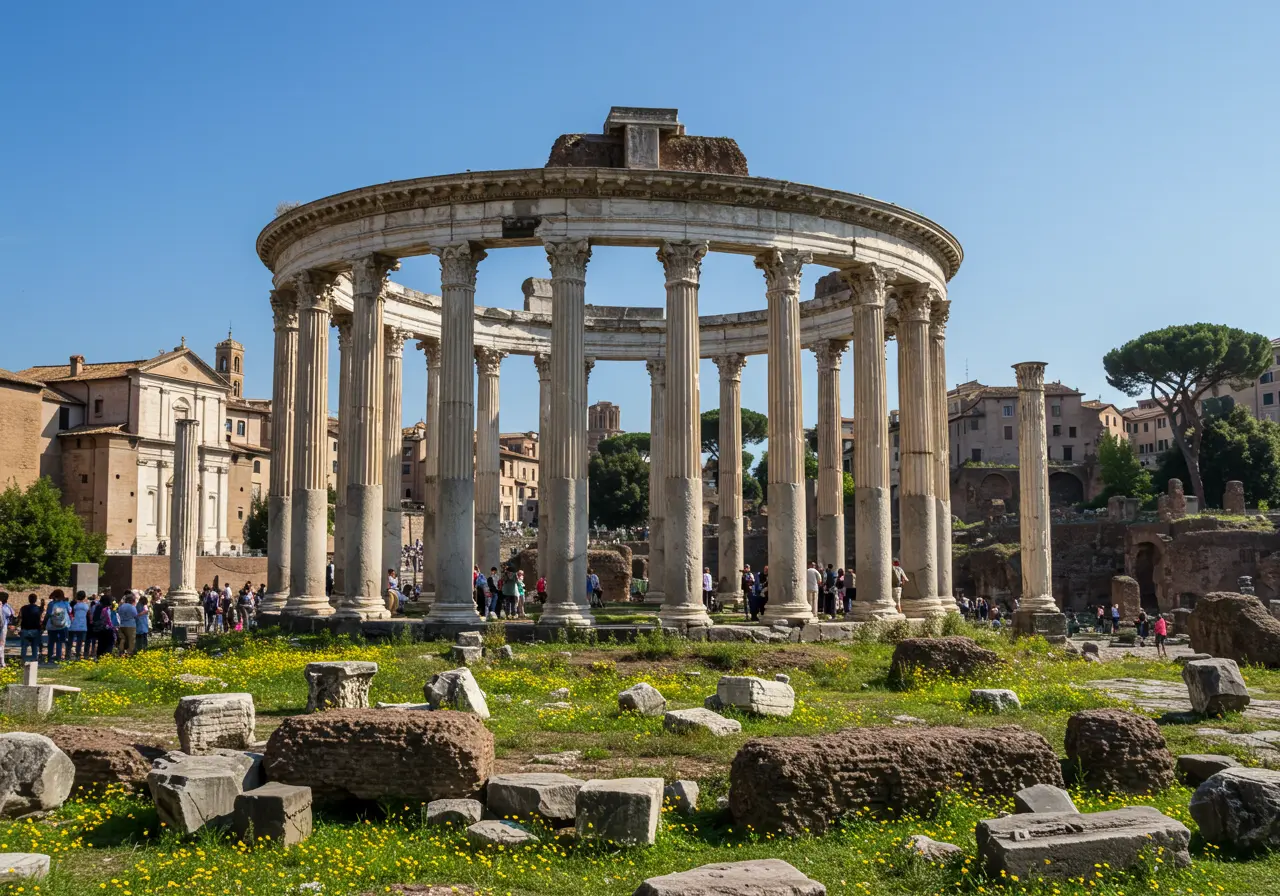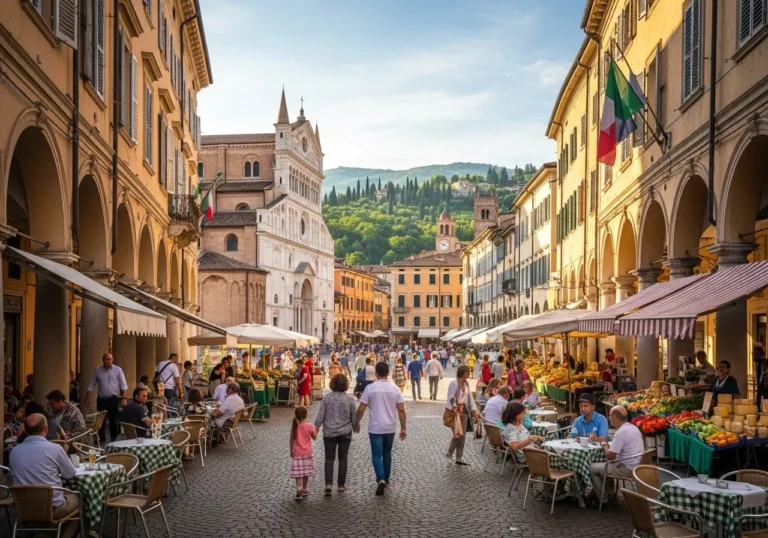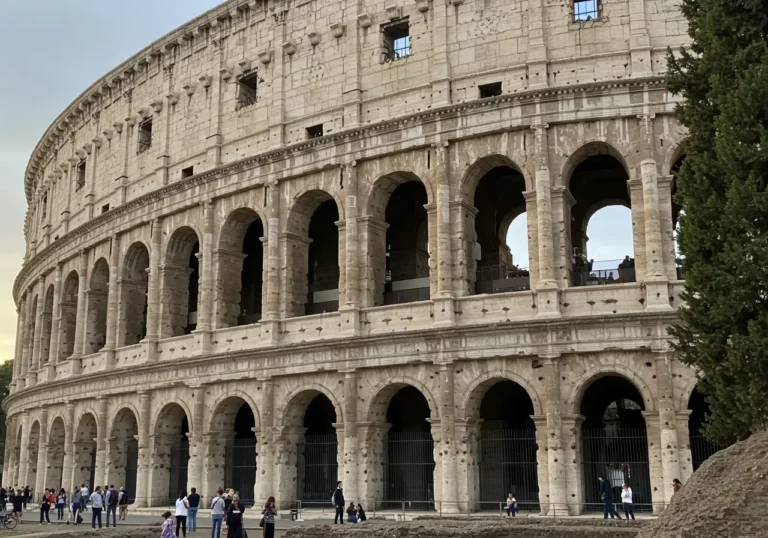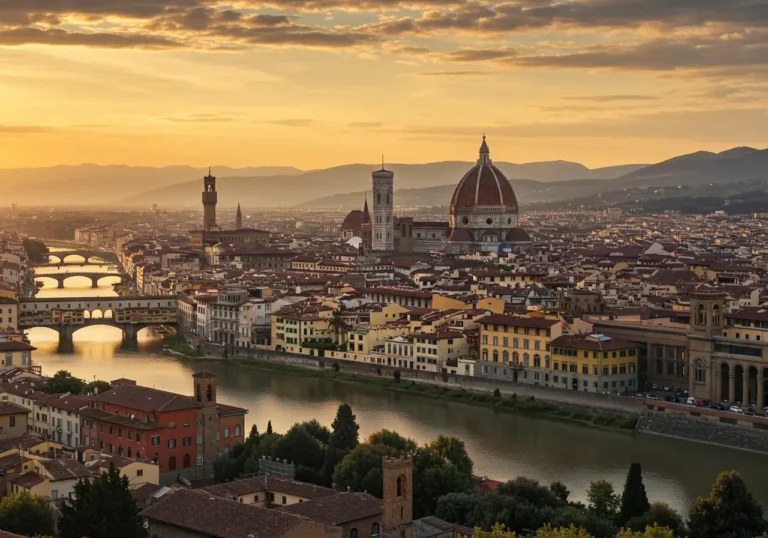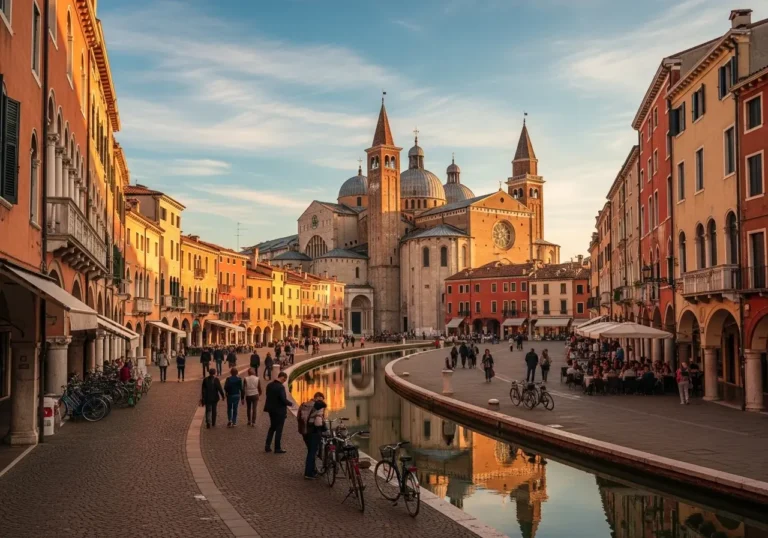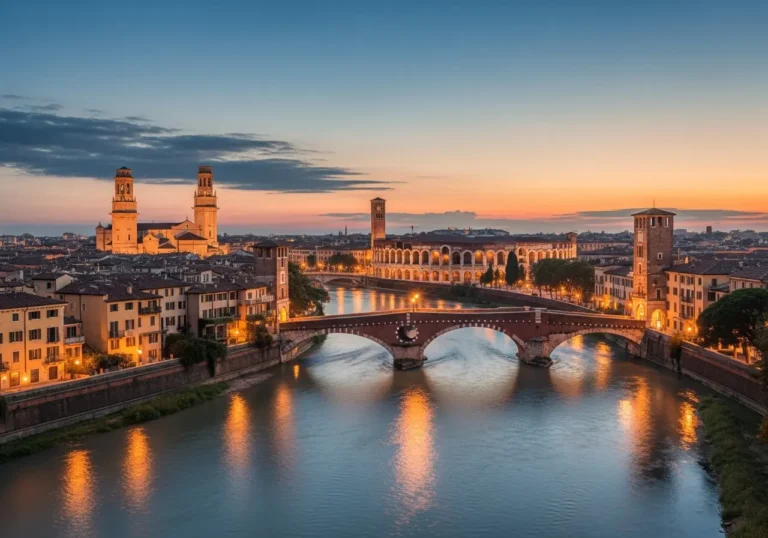10 Stunning Views You’ll Find at the Roman Forum
Introduction
Overwhelmed by planning the perfect Rome itinerary? Standing in the heart of ancient Rome, you’ll discover breathtaking vistas that have captivated visitors for centuries. This comprehensive guide reveals the most spectacular viewpoints at the Roman Forum, ensuring you don’t miss these iconic perspectives that define the eternal city.
As a travel strategist specializing in Italian destinations, I’ve spent years exploring Rome’s archaeological treasures and photographing its most magnificent angles. Through countless visits and extensive research, I’ve identified the must-see vantage points that showcase the Forum’s grandeur.
This guide covers the top ten stunning views you’ll encounter, from the majestic Arch of Septimius Severus to the panoramic perspectives from Capitoline Hill, plus essential planning tips, travel advice, and frequently asked questions to enhance your Roman adventure.
Table of Contents
Why Visit Italy
Italy offers an unparalleled combination of cultural richness, historical significance, and natural beauty that makes it a premier travel destination. The country seamlessly blends ancient wonders with modern conveniences, creating an accessible yet authentic experience for every type of traveler.
Key reasons to choose Italy for your next adventure:
• Offers world-class art, history, and cuisine – From Renaissance masterpieces to Roman ruins and culinary traditions spanning millennia
• Easy transport between cities and regions – Efficient train networks and well-connected airports make exploring multiple destinations effortless
• Perfect for romantic getaways, family trips, or adventure seekers – Diverse experiences cater to honeymooners, families with children, and thrill-seekers alike
10 Stunning Views You’ll Find at the Roman Forum
The Roman Forum offers numerous spectacular viewpoints that showcase ancient Rome’s architectural grandeur and historical significance. These carefully selected vantage points provide photographers and history enthusiasts with unforgettable perspectives of the archaeological site.

Arch of Septimius Severus framed by ancient ruins
The triumphal arch dedicated to Emperor Septimius Severus creates a magnificent focal point when framed by surrounding ruins. Built in 203 AD, this well-preserved monument showcases intricate relief sculptures depicting military victories. The arch’s positioning at the Forum’s northwest end provides stunning photographic opportunities, especially during golden hour when warm light illuminates the marble surfaces. Visitors can capture the arch’s grandeur while incorporating fragments of temples and basilicas in the foreground, creating layered compositions that emphasize the site’s historical depth and architectural complexity.
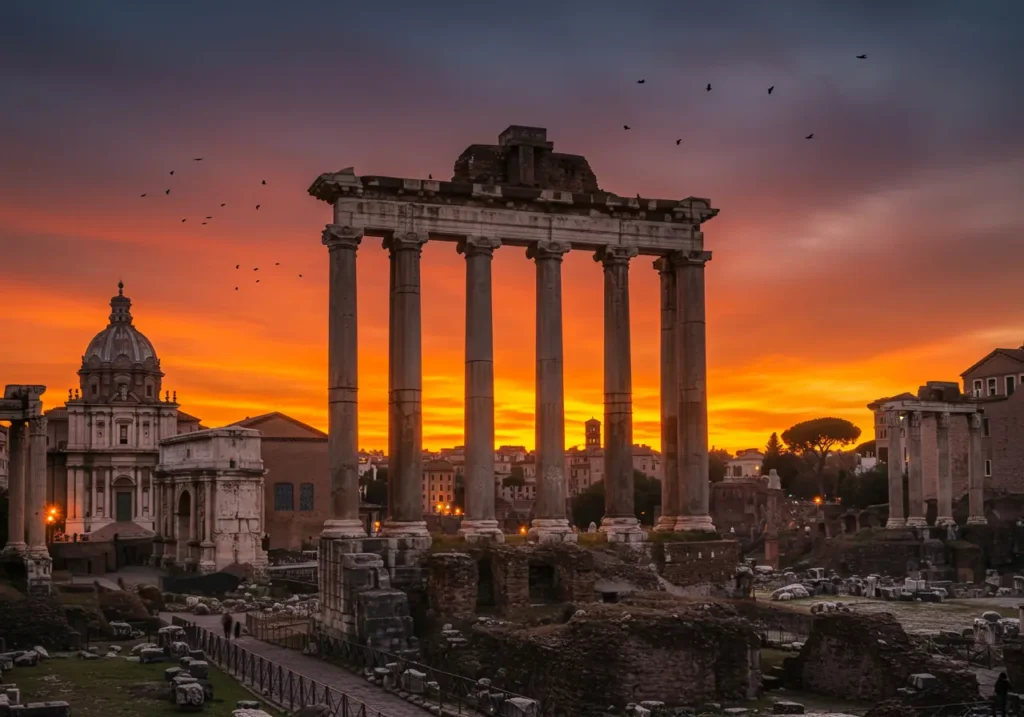
Temple of Saturn with iconic columns at sunset
Eight towering columns mark the remains of one of Rome’s most ancient temples, dedicated to the god Saturn. These Ionic columns, dating from the 4th century AD reconstruction, stand majestically against the Roman sky, creating dramatic silhouettes during sunset hours. The temple housed Rome’s state treasury and served as the focal point for Saturnalia celebrations. Photographers will find the western orientation perfect for capturing golden light filtering through the columns, while historians appreciate viewing the podium where countless Roman ceremonies took place throughout the empire’s history.

View of the Colosseum from the Forum’s edge
From the Forum’s southeastern boundary, visitors enjoy one of Rome’s most iconic views: the Colosseum rising beyond the Temple of Venus and Roma. This perspective showcases the relationship between Rome’s political center and its entertainment district, illustrating urban planning principles that influenced Western civilization. The view encompasses nearly 2,000 years of architectural evolution, from Republican-era temples to Imperial amphitheater construction. Early morning visits provide optimal lighting conditions and fewer crowds, allowing contemplation of gladiatorial games and political spectacles that once captivated Roman audiences from these very viewpoints.
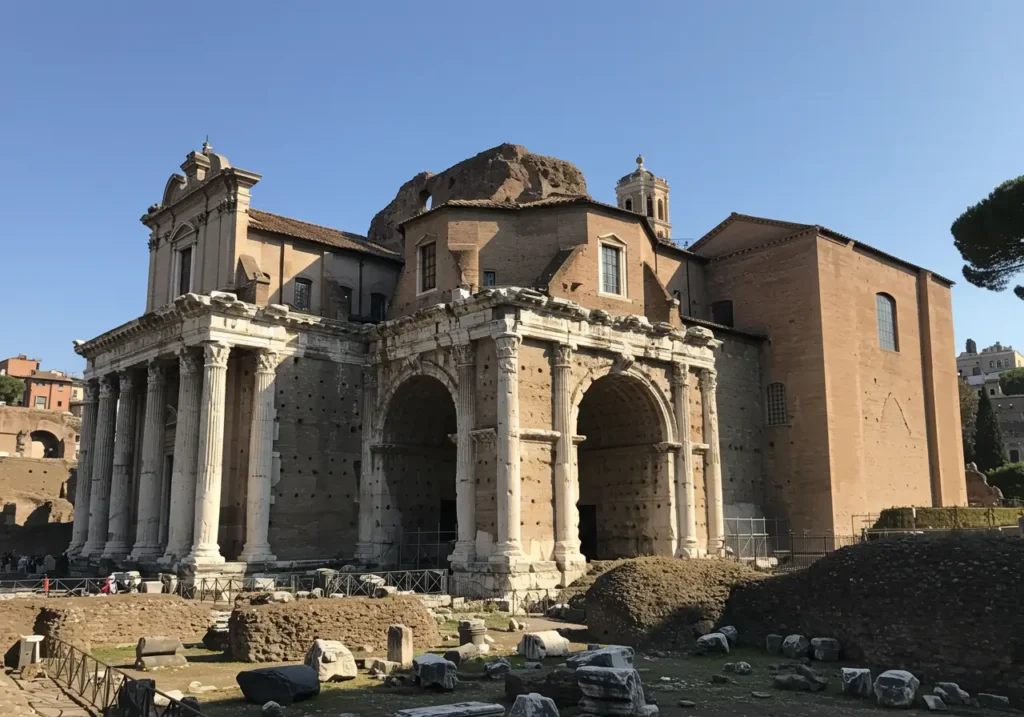
Basilica of Maxentius towering arches
The massive concrete arches of the Basilica of Maxentius represent Roman engineering at its pinnacle. These soaring vaults, reaching 35 meters in height, demonstrate advanced architectural techniques that influenced Renaissance and modern construction methods. Only the north aisle survives, but the remaining structure conveys the building’s original grandeur and scale. Visitors standing beneath these arches experience the same awe that impressed ancient Romans, understanding how this massive hall served as a model for Christian basilicas.
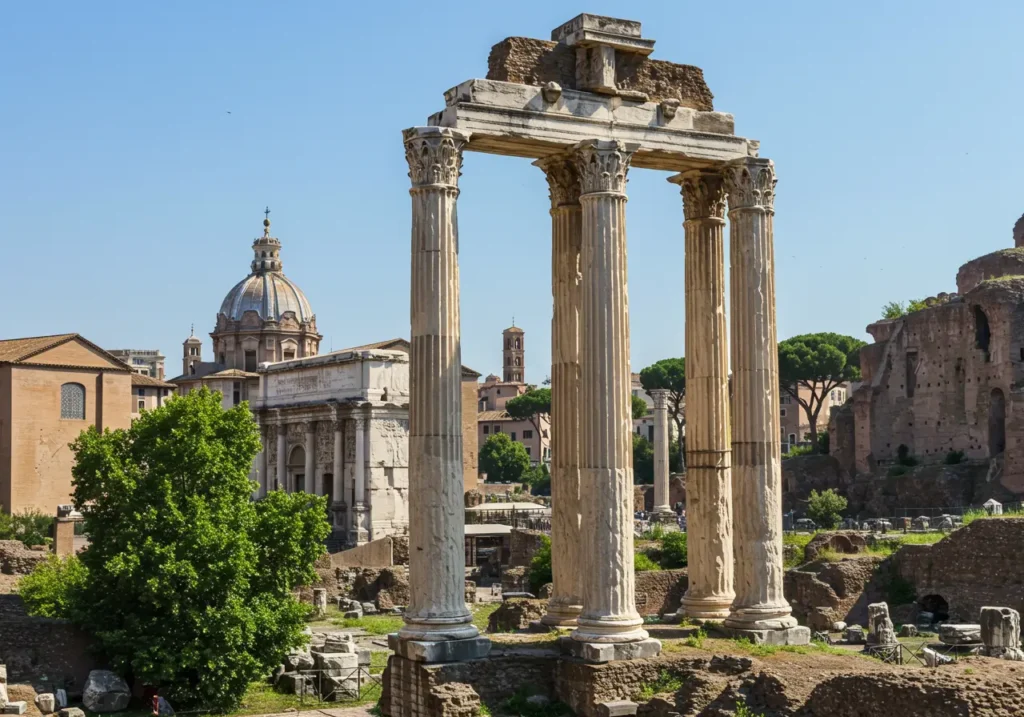
Temple of Castor and Pollux triple columns
Three elegant Corinthian columns mark the Temple of Castor and Pollux, honoring the divine twins who allegedly aided Roman victory at the Battle of Lake Regillus. These 12-meter columns, dating from Tiberius’ reconstruction, showcase the refinement of Roman architectural proportions and decorative elements. The temple’s positioning near the Forum’s center made it a crucial meeting place for senators and merchants. Visitors can appreciate the columns’ fluted shafts and ornate capitals while imagining the bustling commercial activity that surrounded this sacred space, where business transactions required divine blessing from the patron gods of trade and navigation.
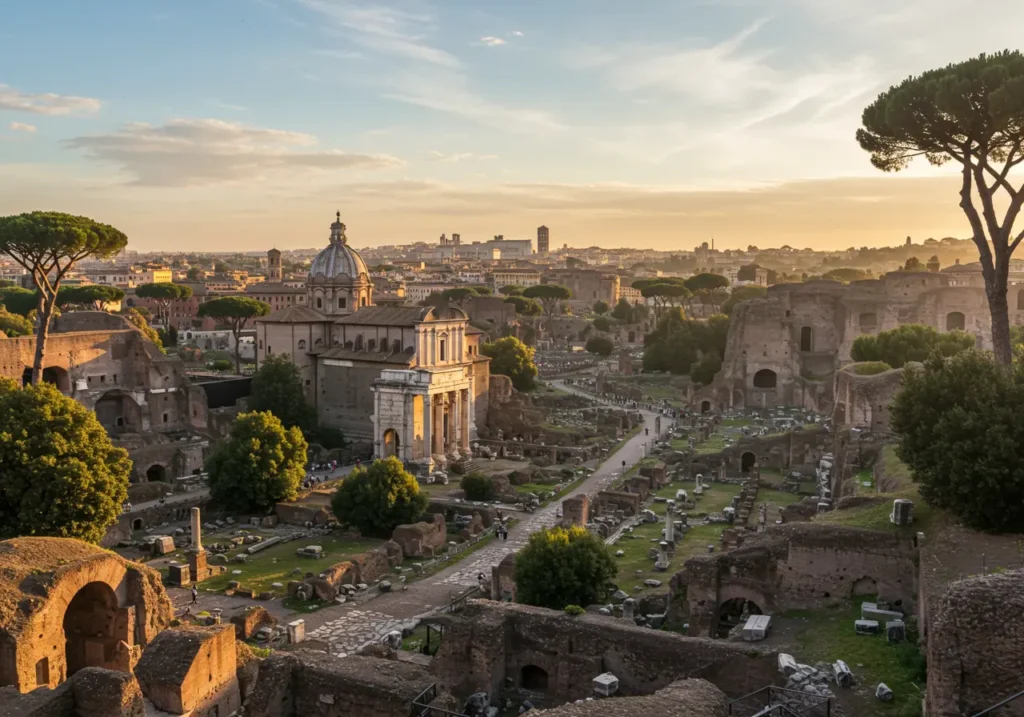
Palatine Hill overlooking the Forum
The elevated perspective from Palatine Hill provides the most comprehensive view of the entire Forum complex. From this vantage point, visitors understand the Forum’s layout, architectural relationships, and urban planning principles that governed ancient Rome’s development. The hill’s imperial palaces created a dramatic backdrop for Forum activities, symbolizing the connection between political power and religious authority. This overview reveals the Forum’s evolution from marketplace to ceremonial center, allowing identification of different construction periods and architectural styles. Archaeological evidence suggests this viewpoint inspired countless imperial decisions that shaped the Roman world.

Via Sacra, the ancient road through history
The Sacred Way winds through the Forum’s heart, connecting the Capitoline and Palatine hills while passing Rome’s most important temples and monuments. Walking this ancient thoroughfare, visitors follow the same path used by triumphant generals, religious processions, and countless Roman citizens throughout the empire’s history. The road’s worn stones tell stories of imperial celebrations, religious festivals, and daily life in ancient Rome. Strategic viewpoints along Via Sacra offer multiple perspectives of surrounding monuments, creating opportunities to appreciate the Forum’s architectural harmony and understand the ceremonial significance of this processional route through Rome’s religious and political center.
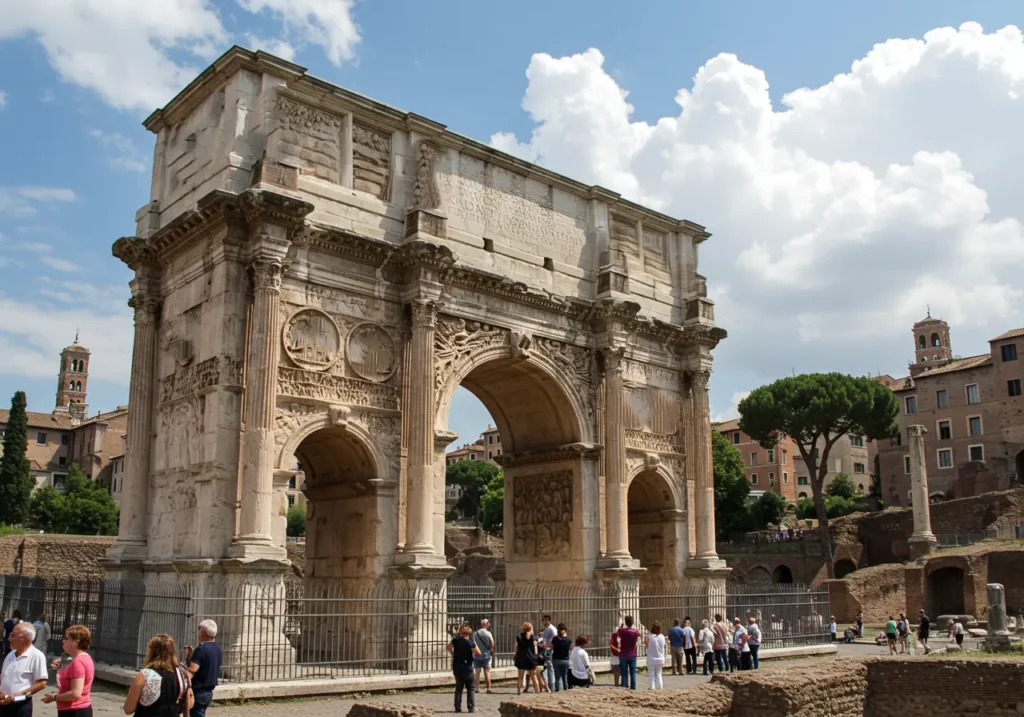
Arch of Titus with detailed carvings
The Arch of Titus commemorates the emperor’s victories in the Jewish Wars, featuring some of ancient Rome’s finest relief sculptures. The arch’s interior panels depict the spoils of Jerusalem’s temple, including the golden menorah, providing historical documentation of this pivotal moment in Roman-Jewish relations. The monument’s strategic placement at Via Sacra’s highest point creates commanding views across the Forum while serving as a powerful symbol of imperial triumph. Visitors can examine the intricate carving techniques that influenced later European commemorative architecture while contemplating the historical events that shaped both Roman and Jewish civilizations through this artistic masterpiece.
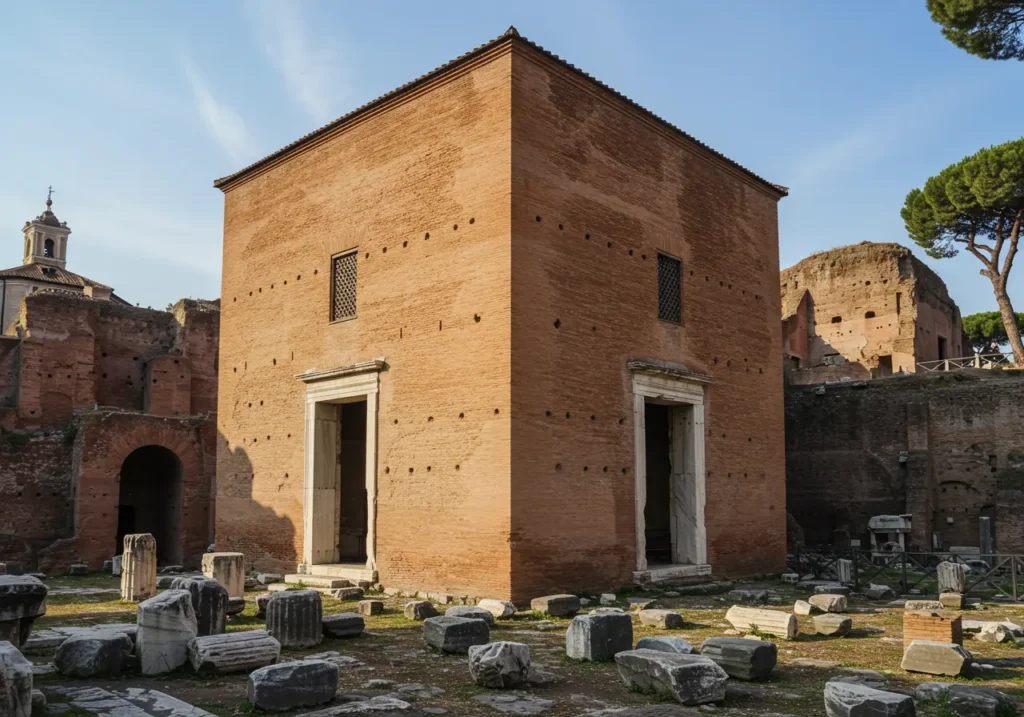
Curia Julia, the Roman Senate building
The reconstructed Senate house stands as a testament to Roman political institutions and architectural preservation efforts. This rectangular building, rebuilt by Diocletian after fire damage, housed the Roman Senate for centuries and witnessed debates that determined the Mediterranean world’s fate. The Curia’s simple exterior contrasts with its historical significance, demonstrating how Roman architecture balanced functionality with symbolic importance. Visitors can view the building’s proportions and imagine senators debating legislation that affected millions of imperial subjects. The structure’s survival through medieval and Renaissance periods illustrates Rome’s continuous occupation and adaptation of ancient monuments for contemporary purposes.
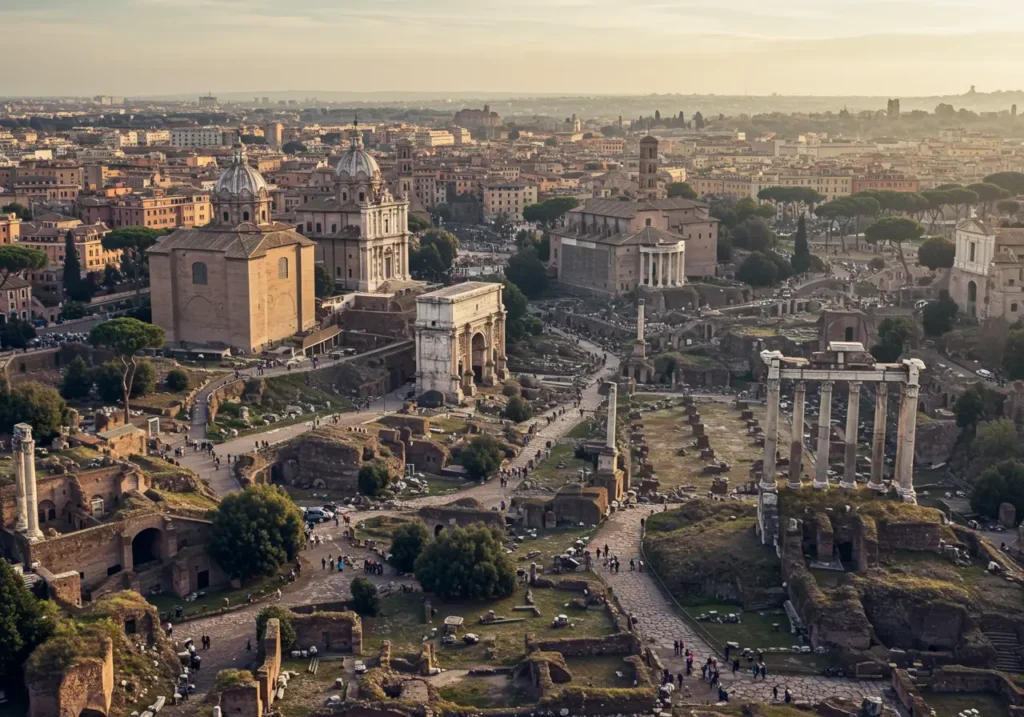
Panoramic view from Capitoline Hill
Capitoline Hill offers the ultimate panoramic perspective of the Roman Forum, providing photographers and historians with comprehensive views of the archaeological site. This elevated position reveals the Forum’s relationship to surrounding hills, the Colosseum, and modern Rome, creating temporal connections between ancient and contemporary urban landscapes. The viewpoint includes multiple terraces and angles, allowing visitors to capture different perspectives throughout the day as lighting conditions change. Renaissance and Baroque buildings frame the ancient ruins, illustrating Rome’s layered history and continuous urban development. This vantage point inspired countless artists, writers, and travelers who documented Rome’s eternal appeal through centuries of cultural exchange.
Choosing the Right Destination
Selecting the perfect Italian destinations depends on your travel style, interests, and time constraints. Italy’s diverse regions offer distinct experiences, from bustling metropolitan centers to serene coastal retreats and dramatic mountain landscapes.
Best Cities for First-Time Travelers: Rome, Florence, Venice
First-time visitors should focus on Italy’s golden triangle: Rome, Florence, and Venice. These iconic cities provide a comprehensive introduction to Italian culture, art, and history. Rome offers ancient wonders and Vatican treasures, Florence showcases Renaissance artistry, and Venice delivers unique canal-side romance. This classic route ensures exposure to Italy’s most celebrated attractions while maintaining manageable travel distances.
Nature Escapes: Dolomites, Lake Como, Amalfi Coast
Nature enthusiasts will find Italy’s landscapes equally compelling. The Dolomites provide world-class hiking and skiing opportunities with dramatic Alpine scenery. Lake Como offers elegant lakeside towns and villa gardens perfect for relaxation. The Amalfi Coast combines stunning coastal drives with charming cliffside villages, creating an ideal blend of natural beauty and cultural immersion.
Substitutions: Swap Cinque Terre with Sardinia for beaches
Consider alternative destinations to avoid crowds while discovering hidden gems. Instead of the popular Cinque Terre, explore Sardinia’s pristine beaches and crystal-clear waters. Sardinia offers similar coastal beauty with fewer tourists, authentic local culture, and diverse landscapes ranging from sandy beaches to rugged interior mountains, providing a more intimate Italian island experience.
Experience Variations
Luxury Travel: Michelin dining, five-star stays
Luxury travelers can enhance their Roman Forum experience with exclusive after-hours tours, private archaeological guides, and premium accommodations near major attractions. Stay at five-star hotels like Hotel de Russie or The First Roma Arte, offering concierge services that arrange VIP access to archaeological sites. Dine at Michelin-starred restaurants such as La Pergola or Glass Hostaria, experiencing contemporary Italian cuisine that honors ancient culinary traditions. Consider helicopter tours over Rome’s historical center, private museum visits, and expert-led seminars on Roman history and archaeology for comprehensive cultural immersion.
Budget-Friendly: Street food tours, hostels, free walking tours
Budget-conscious travelers can explore the Roman Forum affordably through free walking tours, hostel accommodations, and street food experiences. Stay at well-reviewed hostels like The RomeHello or Alessandro Palace, offering dormitory beds and social atmospheres perfect for meeting fellow travelers. Join free walking tours that provide historical context and navigation guidance around major archaeological sites. Sample authentic Roman street food like supplì, maritozzi, and pizza al taglio from local vendors and markets, experiencing genuine flavors at fraction of restaurant costs while supporting neighborhood businesses.
Adventure Travel: Hiking in Dolomites, sailing in Sardinia
Adventure enthusiasts can combine Roman Forum visits with active pursuits throughout Italy’s diverse landscapes. Plan multi-day hiking expeditions in the Dolomites, featuring via ferrata routes and mountain refuges with spectacular Alpine scenery. Organize sailing adventures around Sardinia’s coastline, exploring hidden coves, ancient ruins, and traditional fishing villages accessible only by boat. Consider cycling tours through Tuscany’s wine regions, rock climbing in Sicily, or skiing in the Italian Alps during winter months, creating comprehensive Italian adventures that balance cultural exploration with outdoor activities and physical challenges.
Suggested Itineraries
Strategic itinerary planning maximizes your Italian experience while ensuring adequate time to appreciate the Roman Forum’s historical significance. These curated routes balance must-see attractions with cultural immersion and practical travel considerations.
Pairing cities: “Rome, Florence, Venice in 10 days”
Allocate four days in Rome including comprehensive Forum exploration, three days in Florence for Renaissance art immersion, and three days in Venice for unique canal experiences. Travel by high-speed trains between cities, reserving accommodations near historical centers for walking convenience. Include day trips to Tivoli from Rome, Siena from Florence, and Murano from Venice, expanding cultural understanding while experiencing diverse Italian landscapes and regional traditions.
Coastal & Island Combo: “Amalfi Coast + Capri + Sicily”
Create a Mediterranean island-hopping adventure combining coastal drives with island exploration over 12-14 days. Begin with five days on the Amalfi Coast, exploring Positano, Amalfi, and Ravello while enjoying scenic coastal drives and traditional cuisine. Add three days in Capri for luxury shopping, boat excursions, and the famous Blue Grotto experience. Conclude with six days in Sicily, visiting Palermo’s markets, Mount Etna’s volcanic landscapes, and Taormina’s ancient theaters, creating comprehensive southern Italian cultural immersion with spectacular coastal and mountain scenery throughout.
FAQs
Is it safe to travel in Italy?
Italy is generally very safe for tourists, with low violent crime rates in major tourist areas including Rome and the Forum archaeological zone. Petty theft like pickpocketing occurs in crowded tourist areas, but basic precautions like securing valuables and staying alert minimize risks significantly. Emergency services are reliable and accessible, with multilingual tourist police available in major cities. Political demonstrations occasionally affect transportation but rarely impact tourist activities. Overall safety levels compare favorably to other major European destinations, making Italy suitable for solo travelers, families, and senior citizens.
What’s the best month to visit?
April through June and September through October offer ideal weather conditions with comfortable temperatures, moderate rainfall, and manageable tourist crowds. Spring months feature blooming landscapes and pleasant temperatures perfect for extensive walking tours through archaeological sites. Fall provides warm days, cool evenings, and harvest season celebrations throughout Italian regions. July and August bring intense heat and maximum crowds but longer daylight hours for sightseeing. Winter months offer fewer crowds, lower prices, and mild temperatures but shorter days and occasional rain, requiring flexible scheduling for outdoor activities.
Do I need to speak Italian to get by?
English proficiency varies significantly across Italy, with major tourist areas and younger generations generally speaking conversational English. Tourist information centers, hotels, and restaurants near major attractions typically employ English-speaking staff. Learning basic Italian phrases enhances interactions and demonstrates cultural respect, but language barriers rarely prevent successful navigation or enjoyment of major attractions. Translation apps provide immediate assistance with menus, signs, and conversations. Many museums and archaeological sites offer English audio guides and multilingual signage, ensuring comprehensive understanding of historical and cultural information.
Conclusion
The Roman Forum offers an unparalleled journey through ancient history, where every stone tells stories of emperors, senators, and citizens who shaped Western civilization. These ten stunning viewpoints provide windows into Rome’s glorious past while creating lasting memories for modern travelers seeking cultural enrichment and historical understanding.
From the commanding presence of the Arch of Septimius Severus to the panoramic perspectives from Capitoline Hill, each vantage point reveals different aspects of Roman architectural achievement and urban planning genius. These carefully selected views ensure comprehensive appreciation of the Forum’s significance while providing spectacular photographic opportunities and profound historical connections.
Pack your bags and start exploring Italy’s treasures today! Your Roman adventure awaits, filled with breathtaking vistas, ancient wonders, and cultural discoveries that will transform your understanding of history and inspire lifelong appreciation for human achievement.
Join thousands of travelers who fell in love with Italy’s magic. The Roman Forum’s timeless beauty and historical significance continue captivating visitors from around the world, creating shared experiences that connect modern travelers with ancient civilizations through the universal language of wonder and discovery.

